上海交通大学:《台湾研究》课程教学资源(英文PPT课件)07 Political Interaction across the Taiwan Strait

Political Interaction across the Taiwan Strait Week 6
Political Interaction across the Taiwan Strait Week 6
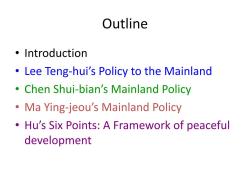
Outline 。Introduction Lee Teng-hui's Policy to the Mainland Chen Shui-bian's Mainland Policy Ma Ying-jeou's Mainland Policy Hu's Six Points:A Framework of peaceful development
Outline • Introduction • Lee Teng-hui’s Policy to the Mainland • Chen Shui-bian’s Mainland Policy • Ma Ying-jeou’s Mainland Policy • Hu’s Six Points: A Framework of peaceful development
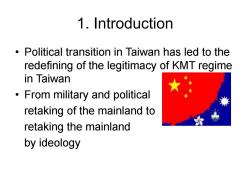
1.Introduction Political transition in Taiwan has led to the redefining of the legitimacy of KMT regime in Taiwan From military and political retaking of the mainland to retaking the mainland by ideology
1. Introduction • Political transition in Taiwan has led to the redefining of the legitimacy of KMT regime in Taiwan • From military and political retaking of the mainland to retaking the mainland by ideology

1.Introduction o Secret messengers between the two sides in mid-1980s Decreasing demand for sovereignty over the mainland Different strategies in gaining maximal votes Continuing opening for visitors to the mainland ● Su Chi-cheng:a special messenger for Lee Teng-hui
1. Introduction • Secret messengers between the two sides in mid-1980s • Decreasing demand for sovereignty over the mainland • Different strategies in gaining maximal votes • Continuing opening for visitors to the mainland • Su Chi-cheng: a special messenger for Lee Teng-hui

2.Lee Teng-hui's Policy to the Mainland A.Weakening the one-China principle To end the period of "mobilization and pacifying the rebellion"(1991) Three stages in National Unification Guideline 1)Exchange of reciprocity 2)Mutual trust and cooperation
2. Lee Teng-hui’s Policy to the Mainland A、Weakening the one-China principle – To end the period of “mobilization and pacifying the rebellion”(1991) – Three stages in National Unification Guideline 1)Exchange of reciprocity 2)Mutual trust and cooperation

1、Veakening the One-China Principle 3)Negotiating on unification Economic liberalization Social pluralization (pluralism) Political democratization Cultural Sinonization (Chinese cultural in Taiwan) -“one country,.two governments” -temporary two Chinas leading to one China in the future (1993) -One country two equivalent entities
1、Weakening the One-China Principle 3) Negotiating on unification • Economic liberalization • Social pluralization (pluralism) • Political democratization • Cultural Sinonization (Chinese cultural in Taiwan) –“one country, two governments” –temporary two Chinas leading to one China in the future(1993) –One country , two equivalent entities
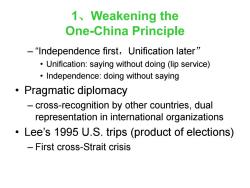
1、Veakening the One-China Principle -“Independence first,.Unification later” Unification:saying without doing (lip service) Independence:doing without saying ·Pragmatic diplomacy cross-recognition by other countries,dual representation in international organizations Lee's 1995 U.S.trips (product of elections) -First cross-Strait crisis
1、Weakening the One-China Principle – “Independence first,Unification later” • Unification: saying without doing (lip service) • Independence: doing without saying • Pragmatic diplomacy – cross-recognition by other countries, dual representation in international organizations • Lee’s 1995 U.S. trips (product of elections) – First cross-Strait crisis
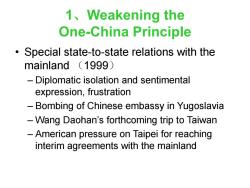
1、Veakening the One-China Principle Special state-to-state relations with the mainland (1999) -Diplomatic isolation and sentimental expression,frustration Bombing of Chinese embassy in Yugoslavia Wang Daohan's forthcoming trip to Taiwan American pressure on Taipei for reaching interim agreements with the mainland
1、Weakening the One-China Principle • Special state-to-state relations with the mainland (1999) – Diplomatic isolation and sentimental expression, frustration – Bombing of Chinese embassy in Yugoslavia – Wang Daohan’s forthcoming trip to Taiwan – American pressure on Taipei for reaching interim agreements with the mainland
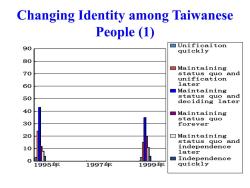
Changing Identity among Taiwanese People (1) 90 □Unificaiton quickly 80 □Maintaining 70 status quo and unification 60 later ■Maintaining 50 status quo and deciding later 40 ☐Maintaining status quo 30 forever 20 □Maintaining status quo and independence later 0 Independence 1995年 1997手 1999年 quickly
Changing Identity among Taiwanese People (1) 0 10 20 30 40 50 60 70 80 90 1995年 1997年 1999年 Unificaiton quickly Maintaining status quo and unification later Maintaining status quo and deciding later Maintaining status quo forever Maintaining status quo and independence later Independence quickly
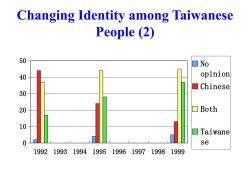
Changing Identity among Taiwanese People (2) 50 □No 40 opinion Chinese 30 20 □Both 10 Taiwane 0 se 1992199319941995199619971998 1999
Changing Identity among Taiwanese People (2) 0 10 20 30 40 50 1992 1993 1994 1995 1996 1997 1998 1999 No opinion Chinese Both Taiwane se
按次数下载不扣除下载券;
注册用户24小时内重复下载只扣除一次;
顺序:VIP每日次数-->可用次数-->下载券;
- 上海交通大学:《台湾研究》课程教学资源(英文PPT课件)06 Politics of Identity.pptx
- 上海交通大学:《台湾研究》课程教学资源(英文PPT课件)05 Taiwan's Party System short.ppt
- 上海交通大学:《台湾研究》课程教学资源(英文PPT课件)04 Party Politics in Taiwan short.ppt
- 上海交通大学:《台湾研究》课程教学资源(英文PPT课件)03 Conditions and Process of Taiwan's Democratization short.ppt
- 上海交通大学:《台湾研究》课程教学资源(英文PPT课件)02 Historical Roots of the Taiwan Issue short.ppt
- 上海交通大学:《台湾研究》课程教学资源(英文PPT课件)01 Introduction short.ppt
- 上海交通大学:《当代中国外交》课程教学资源_Lesson 9_问题讨论_lesson 9 问题讨论.docx
- 上海交通大学:《当代中国外交》课程教学资源_Lesson 9_中文阅读材料_结构失衡_中苏同盟破裂的深层原因.pdf
- 上海交通大学:《当代中国外交》课程教学资源_Lesson 9_中文阅读材料_张曙光著_经济冷战_美国对华经济禁运和中苏同盟.pdf
- 上海交通大学:《当代中国外交》课程教学资源_Lesson 9_中文阅读材料_中苏关系破裂原因_研究述评.pdf
- 上海交通大学:《当代中国外交》课程教学资源_Lesson 9_中文阅读材料_50年代末至60年代中苏关系恶化的战略_理论与利益背景.pdf
- 上海交通大学:《当代中国外交》课程教学资源_Lesson 8_问题讨论_lesson 8 问题讨论.docx
- 上海交通大学:《当代中国外交》课程教学资源_Lesson 8_中文阅读材料_中苏在援越抗美问题上的冲突与矛盾_1965_1972_下.pdf
- 上海交通大学:《当代中国外交》课程教学资源_Lesson 8_中文阅读材料_中苏在援越抗美问题上的冲突与矛盾_1965_1972_上.pdf
- 上海交通大学:《当代中国外交》课程教学资源_Lesson 8_中文阅读材料_抗美援朝_与_援越抗美_中国如何应对朝鲜战争和越南战争_章百家.pdf
- 上海交通大学:《当代中国外交》课程教学资源_Lesson 7_问题讨论_lesson 7 问题讨论.docx
- 上海交通大学:《当代中国外交》课程教学资源_Lesson 7_中文阅读材料_难以弥合的裂痕_苏联对中印冲突的立场及中苏分歧公开化_1959_1960.pdf
- 上海交通大学:《当代中国外交》课程教学资源_Lesson 7_中文阅读材料_关于1962年中印边界冲突和中苏分裂研究的若干问题.pdf
- 上海交通大学:《当代中国外交》课程教学资源_Lesson 7_中文阅读材料_中印边界冲突与苏联的反应和政策.pdf
- 上海交通大学:《当代中国外交》课程教学资源_Lesson 7_English materials_中国和印度关于西藏币制改革的交涉及影响 1959——1962.pdf
- 上海交通大学:《台湾研究》课程教学资源(英文PPT课件)08 Civic Exchange across the Taiwan Strait.ppt
- 上海交通大学:《台湾研究》课程教学资源(英文PPT课件)09-10 U.S.-Taiwan Relations.ppt
- 上海交通大学:《台湾研究》课程教学资源(英文PPT课件)11 Prospects of Cross-Strait Relations short.ppt
- 上海交通大学:《台湾研究》课程教学资源_China's National Identity under Reconstruction.docx
- 上海交通大学:《台湾研究》课程教学资源_Party Politics.docx
- 上海交通大学:《台湾研究》课程教学资源_再论台湾两党体系的可延续.pdf
- 上海交通大学:《台湾研究》课程教学资源(中文PPT课件)03 台湾政治转型的启动.ppt
- 上海交通大学:《台湾研究》课程教学资源(中文PPT课件)04 台湾政治转型的嬗变.ppt
- 上海交通大学:《台湾研究》课程教学资源(中文PPT课件)05 台湾政治转型与涉外关系.ppt
- 上海交通大学:《台湾研究》课程教学资源(中文PPT课件)06 政治转型与美台关系.ppt
- 上海交通大学:《台湾研究》课程教学资源(中文PPT课件)07 台湾政治转型与大陆政策.ppt
- 上海交通大学:《台湾研究》课程教学资源(中文PPT课件)08 台湾政治转型与大陆对台政策.ppt
- 上海交通大学:《台湾研究》课程教学资源(中文PPT课件)09 台湾政治转型与两岸关系.ppt
- 上海交通大学:《台湾研究》课程教学资源(中文PPT课件)10 两岸关系和平发展的前景.ppt
- 上海交通大学:《台湾研究》课程教学资源_阅读材料_2012年台湾选举对政党体系的影响.pdf
- 上海交通大学:《台湾研究》课程教学资源_阅读材料_两岸关系和平发展的机遇和路径.pdf
- 上海交通大学:《台湾研究》课程教学资源_阅读材料_台海问题中的美国因素.pdf
- 上海交通大学:《台湾研究》课程教学资源_阅读材料_台湾当局_活路外交_评析.pdf
- 上海交通大学:《台湾研究》课程教学资源_阅读材料_台湾政党体系发展趋势探析.pdf
- 上海交通大学:《台湾研究》课程教学资源_阅读材料_台湾问题_美国对华政策中的两难议题.pdf
